load capacity MERCEDES-BENZ METRIS 2021 MY21 Operator's Manual
[x] Cancel search | Manufacturer: MERCEDES-BENZ, Model Year: 2021, Model line: METRIS, Model: MERCEDES-BENZ METRIS 2021Pages: 290, PDF Size: 4.68 MB
Page 133 of 290
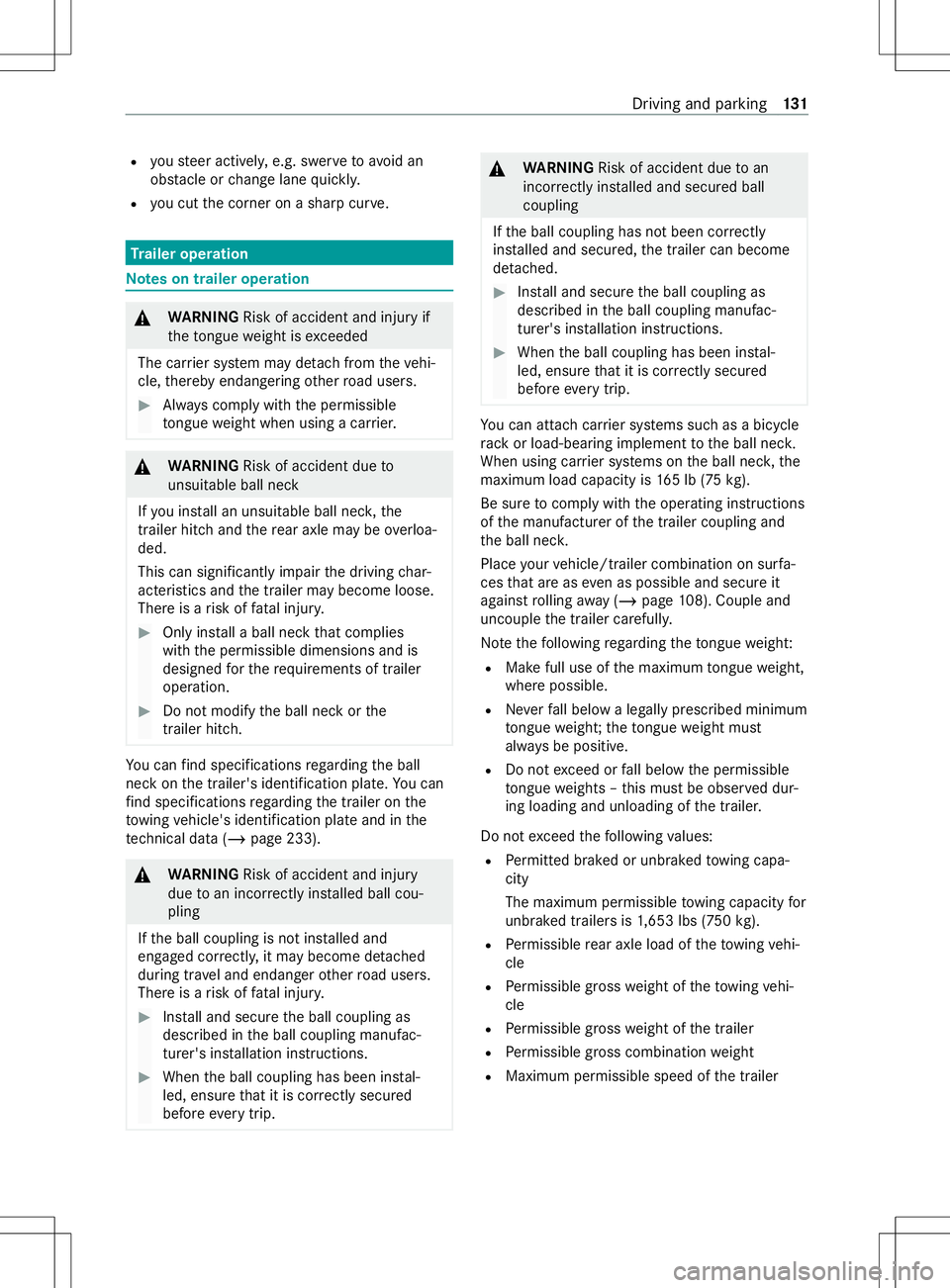
R
yous teer actively ,e.g. swer vetoavoid an
obs tacle or chang elane quickl y.
R youc utthec orner on ashar pcurve. Tr
aile roperation Note
sont railer operation &
WARNING Risk of accident and inju ryif
th et ongue weight is exceeded
The car rier sy stem ma ydetac hf romt hevehi‐
cle, thereb yendangering other road users. #
Alwaysc ompl ywitht he permissible
to ngu eweight when using acarrier. &
WARNING Risk of accident du eto
unsuitable ball neck
If yo ui nstall an unsuitable ball nec k,the
traile rhitch and ther ear axle ma ybeoverloa‐
ded.
This can significantl yimp air thed riving char‐
acteristic sand thet railer ma ybecome loose.
Ther eisar isk offata linjur y. #
Only ins tallab all nec kthat complies
wit hthe permissible dimensions and is
designed fort he requ irements of trailer
operation. #
Do no tmodif ythe ball nec korthe
trailer hitch. Yo
uc an find specifications rega rding theb all
nec kont he trailer's identification plate. Youc an
fi nd specifications rega rding thet railer on the
to wing vehicle's identification plat eand in the
te ch nica ldata( /pag e233). &
WARNING Risk of accident and inju ry
due toan incor rectly ins talled ball cou‐
pling
If th eb all coupling is no tins talled and
engaged cor rectl y,it ma ybecom edetached
during tra vela nd endan gero ther road users.
Ther eisar isk offata linjur y. #
Install and secur ethe ball coupling as
described in theb all coupling manufac‐
turer's ins tallation instructions. #
When theb all coupling has been ins tal‐
led, ensur ethat it is cor rectly secu red
befor eevery trip. &
WARNING Risk of accident du etoan
incor rectl yins tal led and secured ball
coupling
If th eb all coupling has no tbeen cor rectly
ins talled and secured, thet railer can become
de tach ed. #
Install and secur ethe ball coupling as
described in theb all coupling manufac‐
turer's ins tallation instructions. #
When theb all coupling has been ins tal‐
led, ensur ethat it is cor rectly secu red
befor eevery trip. Yo
uc an attac hcarrier sy stems suc hasabicycle
ra ck or load-bearing implement totheb all nec k.
When using car rier sy stems on theb all nec k,the
maximu mloadc apacity is 165lb( 75kg).
Be sur etocomply wi th theoperating instructions
of them anufacturer of thet railer coupling and
th eb all nec k.
Place your vehicle/trailer combination on sur fa‐
ces that ar ease vena spossible and secu reit
agains trolling away ( /pag e108). Coupl eand
uncoupl ethe trailer carefully.
No tethef ollowing rega rding thet ongue weight:
R Mak efull use of them aximum tongu eweight,
wher epossible.
R Neverfall belo walegally prescribed minimum
to ngu eweight ;the tongu eweight must
alw aysbep ositive.
R Do no texceed or fall belo wthe permissible
to ngu eweights –this mus tbeobservedd ur‐
ing loading and unloading of thet railer.
Do no texceed thef ollowing values:
R Perm itted braked or unbraked towing capa‐
city
The maximum permissible towing capacity for
unbraked trailer sis1,653 lbs (750 kg).
R Perm issible rear axle load of thet ow ing vehi‐
cle
R Perm issible gross weight of thet ow ing vehi‐
cle
R Perm issible grossweight of thet railer
R Perm issible grosscombination weight
R Maximum permissible speed of thet railer Driving and parking
131
Page 168 of 290
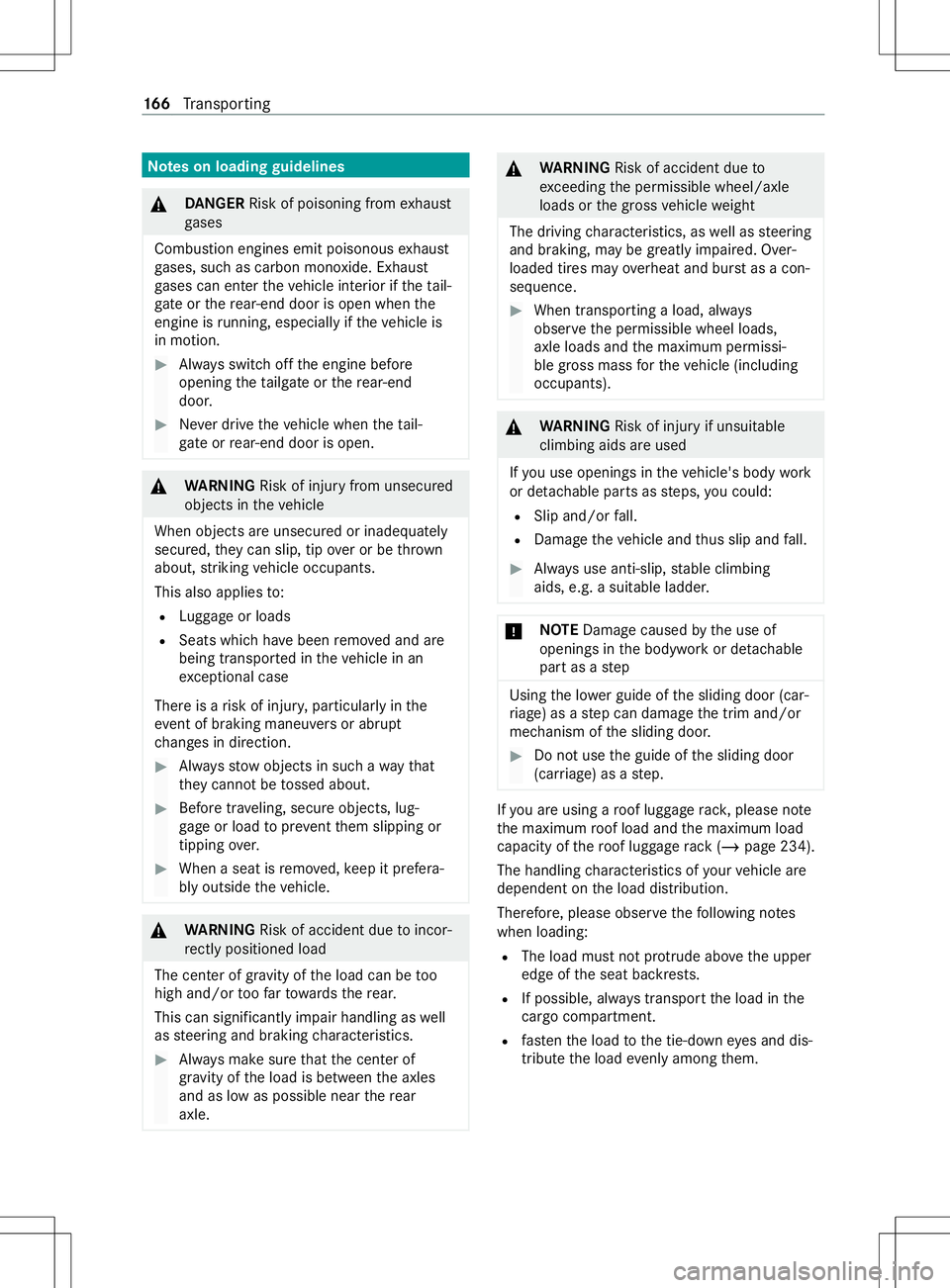
Note
sonl oading guidelines &
DANG ER Risk of poisonin gfrome xhau st
ga ses
Combustion engines emit poisonous exhaust
ga ses, suc hascarbon monoxide. Exhaust
ga ses can enter thev ehicle interior if thet ail‐
gate orther ear-end door is open when the
engine is running ,especial lyifth ev ehicle is
in motion. #
Alwayss witc hoffthee ngine before
opening thet ailgat eortherear-end
door. #
Neverd rive thev ehicle when thet ail‐
ga te or rear-en ddoor is open. &
WARNING Risk of inju ryfrom unsecu red
object sinthevehicle
When objects ar eunsecured or inadequately
secured, they can slip, tip overorbet hrown
about, striking vehicle occupants.
This also appliest o:
R Luggag eorl oads
R Seats whic hhave been remo veda nd are
being transpor tedint hevehicle in an
ex ceptiona lcase
The reisar isk of injur y,particular lyin the
eve nt of braking maneuver sorabrupt
ch anges in direction. #
Alwayss towo bjectsins uchaw aythat
th ey canno tbetossed about. #
Befor etrave ling, secur eobjects, lug‐
ga ge or load topreve ntthem slipping or
tipping over. #
When aseat is remo ved, keep it prefera‐
bly outside thev ehicle. &
WARNING Risk of accident du etoincor‐
re ctly positioned load
The center of gr avity of thel oad can be too
high and/or toof ar towa rdst he rear.
This can significantl yimp air handlin gaswell
as steering and braking characteristics. #
Alwaysm akes uret hat thec enter of
gr av ity of thel oad is between thea xles
and as lo waspossible near ther ear
axle. &
WARNING Risk of accident du eto
exc eeding thep ermissible wheel/axle
loads or theg ross vehicle weight
The driving characteristics, as well as steering
and braking, ma ybegreatl yimp aired. Over‐
loaded tires ma yoverheat and bur stas ac on‐
sequence. #
When transpo rting aload, alw ays
obser vethep ermissible wheel loads,
axle loads and them aximum permissi‐
ble gross mass fort he vehicle (including
occupants). &
WARNING Risk of inju ryif unsuitable
climbin gaids ar eused
If yo uu se opening sinthevehicle's body work
or de tach able parts as steps, youc ould:
R Slip and/or fall.
R Damag ethe vehicle and thus slip and fall. #
Alwaysu se anti-slip, stable climbing
aids, e.g .asuitable ladder. *
NO
TEDama gecaused bytheu se of
openings in theb odywor kordetachable
par tasa step Using
thel owe rguide of thes liding door (car‐
ri age) as astepc an damag ethe trim and/or
mechanism of thes liding door. #
Do no tuse theg uide of thes liding door
(car riage) as astep. If
yo ua reusin gar oof luggag erack, please no te
th em aximum roof load and them aximum load
capacity of ther oof luggag erack( / pag e234).
The handling characteristic sofyourvehicle are
dependent on thel oad distribution.
Therefore, please obser vethef ollowing no tes
when loading:
R The load mus tnotprotru de abo vetheu pper
edg eoft he seat backrests.
R If possible, alw ayst ranspor tthe load in the
cargo compa rtment.
R fastenthel oad tothet ie-down eyes and dis‐
tribut ethe load evenl yamong them. 16 6
Transporting
Page 170 of 290
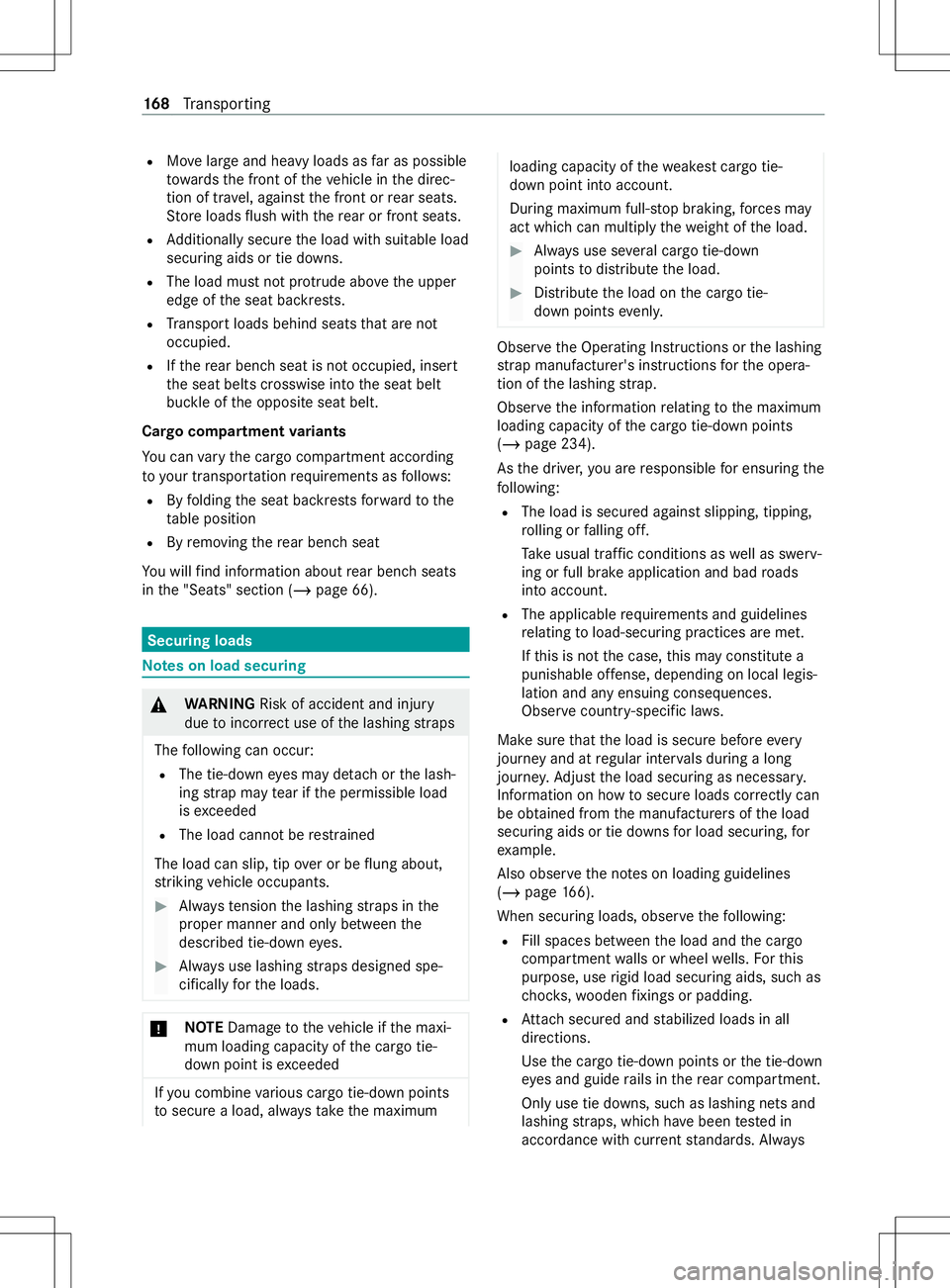
R
Movelarge and heavy loads as farasp ossible
to wa rdst he front of thev ehicle in thed irec‐
tion of tra vel, agains tthe front or rear seats.
St orel oads flush wit hthe rear or front seats.
R Additionall ysecur ethe load wit hsuitable load
securing aids or tie downs.
R The load mus tnotprotru de abo vetheu pper
edg eoft he seat backrests.
R Transpor tloads behin dseat sthat ar enot
occupied.
R Ifth er ear benc hseat is no toccupied, insert
th es eat belts crosswise int othe seat belt
buckle of theo pposit eseat belt.
Cargo compartment variants
Yo uc an vary thec argo compartmen taccording
to your transpor tatio nr equirements as follo ws:
R Byfolding thes eat backrests forw ardtot he
ta ble position
R Byremoving ther ear benc hseat
Yo uw illfind information abou trear benc hseats
in the" Seats" section (/ page66). Securing loads
Note
sonl oad securing &
WARNING Risk of accident and inju ry
due toincor rect use of thel ashing stra ps
The following can occur:
R The tie-down eyes ma ydetac hort he lash‐
ing stra pm aytear if thep ermissible load
is exc eeded
R The load cann otbe restra ined
The load can slip, tip over or be flung about,
st riking vehicle occupants. #
Alwayst ension thel ashing stra ps in the
proper manner and onl ybetwe en the
described tie-down eyes. #
Alwaysu se lashing stra ps designed spe‐
cificall yfor thel oads. *
NO
TEDama getothev ehicle if them axi‐
mum loading capacity of thec argo tie-
down point is exceeded If
yo uc ombin evarious cargo tie-down points
to secur eaload, alw ayst aket he maximum loading capacity of
thew eakes tcargo tie-
down poin tint oa ccount.
During maximum full- stop braking, forc es may
act whic hcan multipl ythe weight of thel oad. #
Alwaysu se se veralc argo tie-down
point stod istribut ethe load. #
Distribut ethe load on thec argo tie-
down points evenly. Obser
vetheO perating Instruction sorthe lashing
st ra pm anufacturer's instruction sfor theo pera‐
tion of thel ashing stra p.
Obser vethei nformation relatin gtot he maximum
loading capacity of thec argo tie-down points
(/ page234).
As thed rive r,yo ua re re sponsible fore nsuring the
fo llowing:
R The load is secured agains tslipping, tipping,
ro lling or falling off.
Ta ke usual traf ficc onditions as well as swerv‐
ing or full brak eapplication and bad roads
int oa ccount.
R The applicable requ irements and guidelines
re latin gtol oad-securing practices ar emet.
If th is is no tthe case, this ma yconstitut ea
punishable of fense, depending on local legis‐
lation and an yensuing conse quences.
Obser vecountr y-specific la ws.
Mak esuret hat thel oad is secur ebefor eevery
jou rney and at regular inter vals during along
journe y.Ad jus tthe load securing as necessar y.
Information on ho wtosecureloads cor rectly can
be obtained from them anufacturer softhe load
securing aids or tie downs forl oa ds ecuring, for
ex ample.
Als oo bse rvet he no tesonl oading guidelines
(/ page166).
Whe nsecuring loads, obser vethef ollowing:
R Fill spaces between thel oad and thec argo
compartmen twalls or wheel wells. Forthis
purpose, use rigid load securing aids, suc has
ch oc ks,w ooden fixing sorp adding.
R Attach secured and stabilized loads in all
directions.
Use thec argo tie-down points or thet ie-down
ey es and guide rails in ther ear compartment.
Only use tie downs, suc haslashin gnetsa nd
lashin gstraps, whic hhave been tested in
accordance wit hcurrent standards. Alw ays 16 8
Transporting
Page 172 of 290
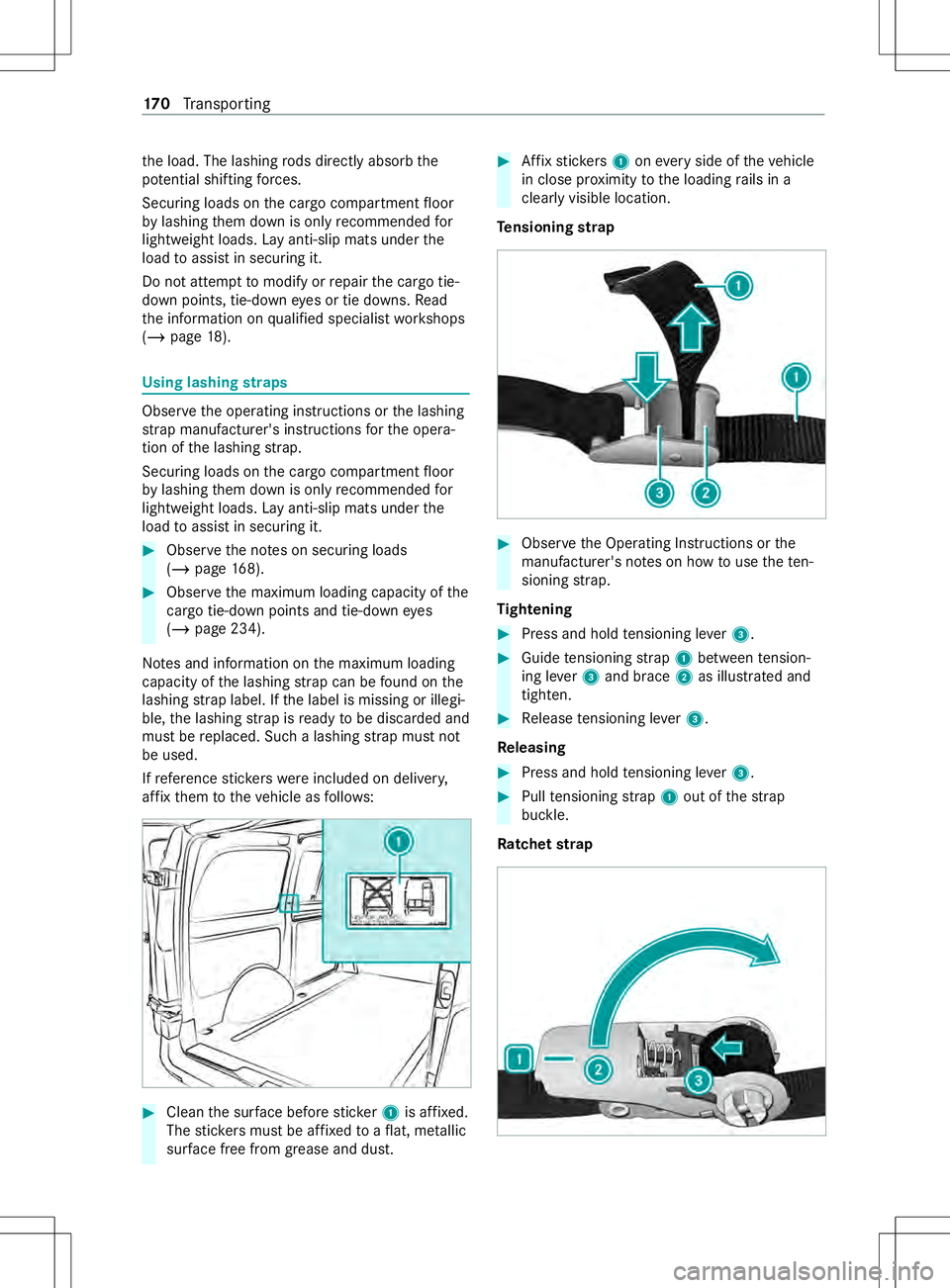
th
el oad. The lashing rods directly absorb the
po tentia lshifting forc es.
Securing loads on thec argo compartmen tfloor
by lashing them down is onl yrecommended for
light weight loads. La yanti-slip mats under the
load toassis tinsecuring it.
Do no tattem pttomodify or repair thec argo tie-
down points ,tie-down eyesort ie downs. Read
th ei nformation on qualified specialis tworks hops
(/ page18). Using lashin
gstraps Obser
vetheo perating instruction sorthe lashing
st ra pm anufacturer's instruction sfor theo pera‐
tion of thel ashing stra p.
Securing loads on thec argo compartmen tfloor
by lashing them down is onl yrecommended for
light weight loads. La yanti-slip mats under the
load toassis tinsecuring it. #
Obse rvet he no tesons ecuring loads
(/ page168). #
Obser vethem aximum loading capacity of the
cargo tie-d ownp oints and tie-down eyes
(/ page234).
No tesa nd information on them aximum loading
capacity of thel ashing stra pc an be found on the
lashing stra pl abel. If thel abel is missing or illegi‐
ble, thel ashing stra pisr eady tobe discarded and
mus tber eplaced. Suc halashing stra pm ustn ot
be used.
If re fere nce sticke rs we reincluded on deliver y,
af fixt hem tothev ehicle as follo ws: #
Clean thes urface befor esticker 1is af fixe d.
The sticke rs mus tbea ffixed toaflat, me tallic
sur face free from grease and du st. #
Affixs tickers 1 oneverys ide of thev ehicle
in close pr oximit ytot he loading rails in a
clearly visible location.
Te nsioning strap #
Obser vetheO perating Instruction sorthe
manufacturer's no tesonh owtouse thet en‐
sioning stra p.
Ti ghtening #
Press and hold tensioning le ver3. #
Guide tensioning strap 1between tension‐
ing le ver3and brace 2as illustrated and
tighten. #
Release tensioning le ver3.
Re leasing #
Press and hold tensioning le ver3. #
Pullt ensioning strap 1out of thes trap
bu ckle.
Ra tche tstrap 17 0
Transporting
Page 177 of 290
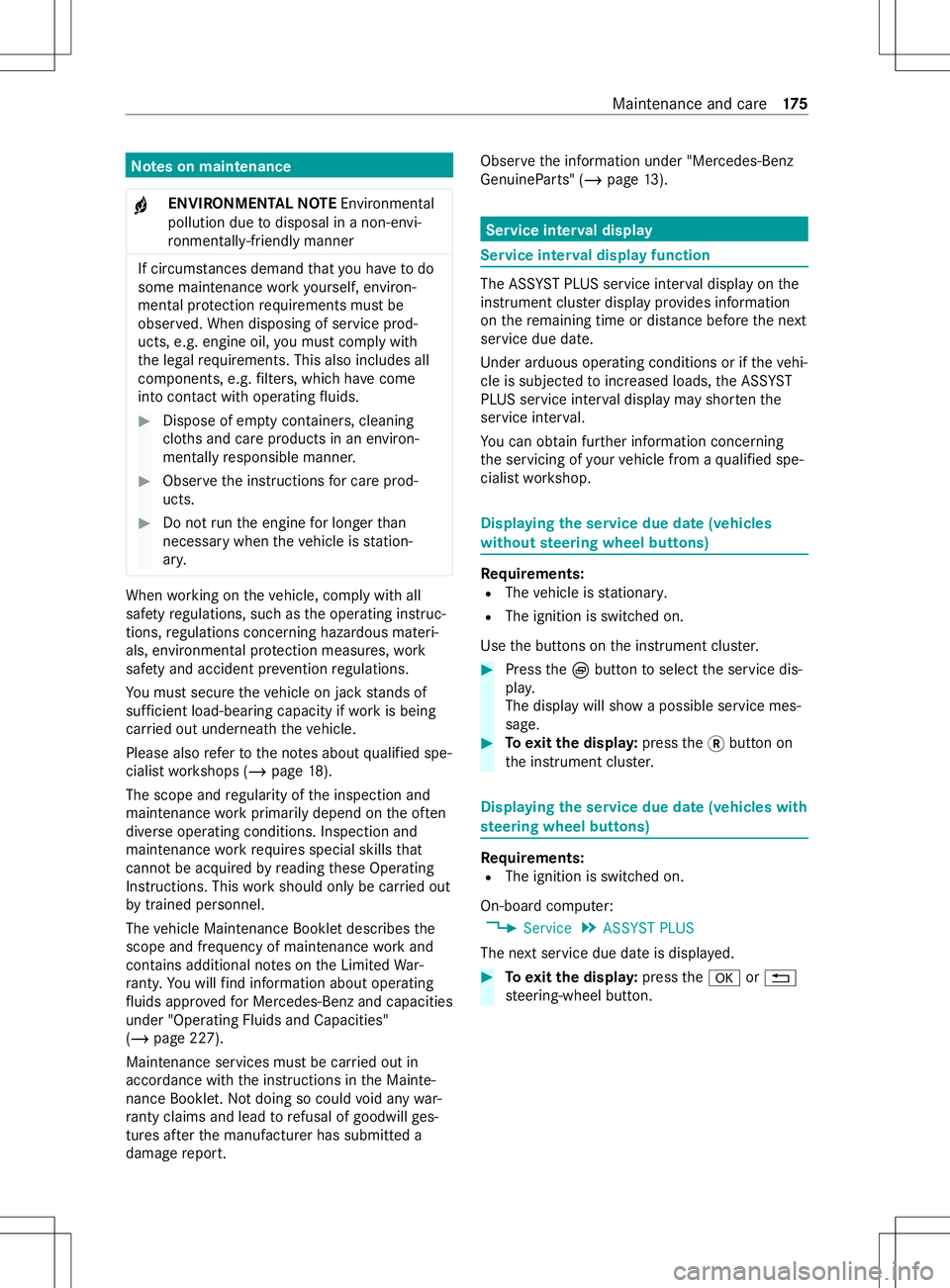
Note
sonm aintenance
+ ENVIRONMEN
TALN OTE Environmental
pollution du etodisposal in anon-envi‐
ro nmentally-friendly manner If circums
tances demand that youh ave todo
some maintenanc eworky ourself, environ‐
mental pr otection requirements mus tbe
obser ved. When disposing of service prod‐
ucts, e.g. engin eoil,youm ustc ompl ywith
th el egal requ irements. This also includes all
components, e.g. filters, whic hhave come
int oc ontact wi thoperating fluids. #
Dispose of em ptyc ontainers, cleaning
clo thsa nd car eproducts in an environ‐
mentally responsible manner. #
Obser vethei nstruction sfor car eprod‐
ucts. #
Do no trun thee ngine forl onger than
necessar ywhen thev ehicle is station‐
ar y. When
working on thev ehicle, comply wit hall
saf etyr egulations, suc hasthe operating instruc‐
tions, regulations concerning hazardous materi‐
als, environmental pr otection measures, work
saf etya nd acciden tpreve ntion regulations.
Yo um usts ecur ethe vehicle on jac kstands of
suf ficient load-bearing capacity if workis being
car ried out underneat hthe vehicle.
Please also refertot he no tesa bout qualified spe‐
cialis tworks hops (/ page18).
The scope and regularity of thei nspection and
maintenanc eworkp rimaril ydepend on theo ften
diverse operating conditions .Inspection and
maintenanc eworkr equires special skills that
canno tbeacquired byreading these Operating
Instructions. This workshould onl ybecarried out
by trained pe rsonnel.
The vehicle Maintenance Bookle tdescribes the
scope and frequency of maintenance workand
contains additional no tesont he Limited War‐
ra nty .You will find information abou toperating
fl uids appr ovedfor Mercedes-Benz and capacities
under "Operatin gFluid sand Capacities"
(/ page 227).
Maintenance services mus tbecarried out in
accordance wit hthe instructions in theM ainte‐
nanc eBooklet. No tdoing so could void an ywar‐
ra nty claims and lead torefusa lofg oodwil lges‐
tures af tert he manufacturer has submitted a
damag ereport. Obser
vethei nformation under "Mercedes-Benz
GenuineParts" (/ page13). Se
rvice inter vald isplay Service inter
vald ispla yfunction The AS
SYST PLUS service inter vald ispla yont he
instrument clus terd ispla yprovide sinformation
on ther emaining time or dis tance be fore then ext
service due date.
Under arduous operating conditions or if thev ehi‐
cle is subjected toinc reased loads, theA SSYST
PLUS service inter vald ispla ymayshor tent he
service inter val.
Yo uc an obtain fur ther information concerning
th es ervicing of your vehicle from aqualified spe‐
cialis tworks hop. Displaying
thes ervice du edate( vehicles
without steering wheel but tons) Requ
irements:
R The vehicle is stationar y.
R The ignition is switched on.
Use theb uttons on thei nstrument clus ter. #
Press theÈbutton toselect thes ervice dis‐
pla y.
The displa ywill sho wapossible service mes‐
sage. #
Toexitth ed ispla y:press the0078button on
th ei nstrument clus ter. Displaying
thes ervice du edate( vehicles with
st eering wheel but tons) Re
quirements:
R The ignition is switched on.
On-boar dcomputer:
4 Service 5
ASSYS TPLUS
The next service due dat eisdisplayed. #
Toexitth ed ispla y:press the0076 or0038
st eering-wheel button. Maintenanc
eand care 175
Page 203 of 290
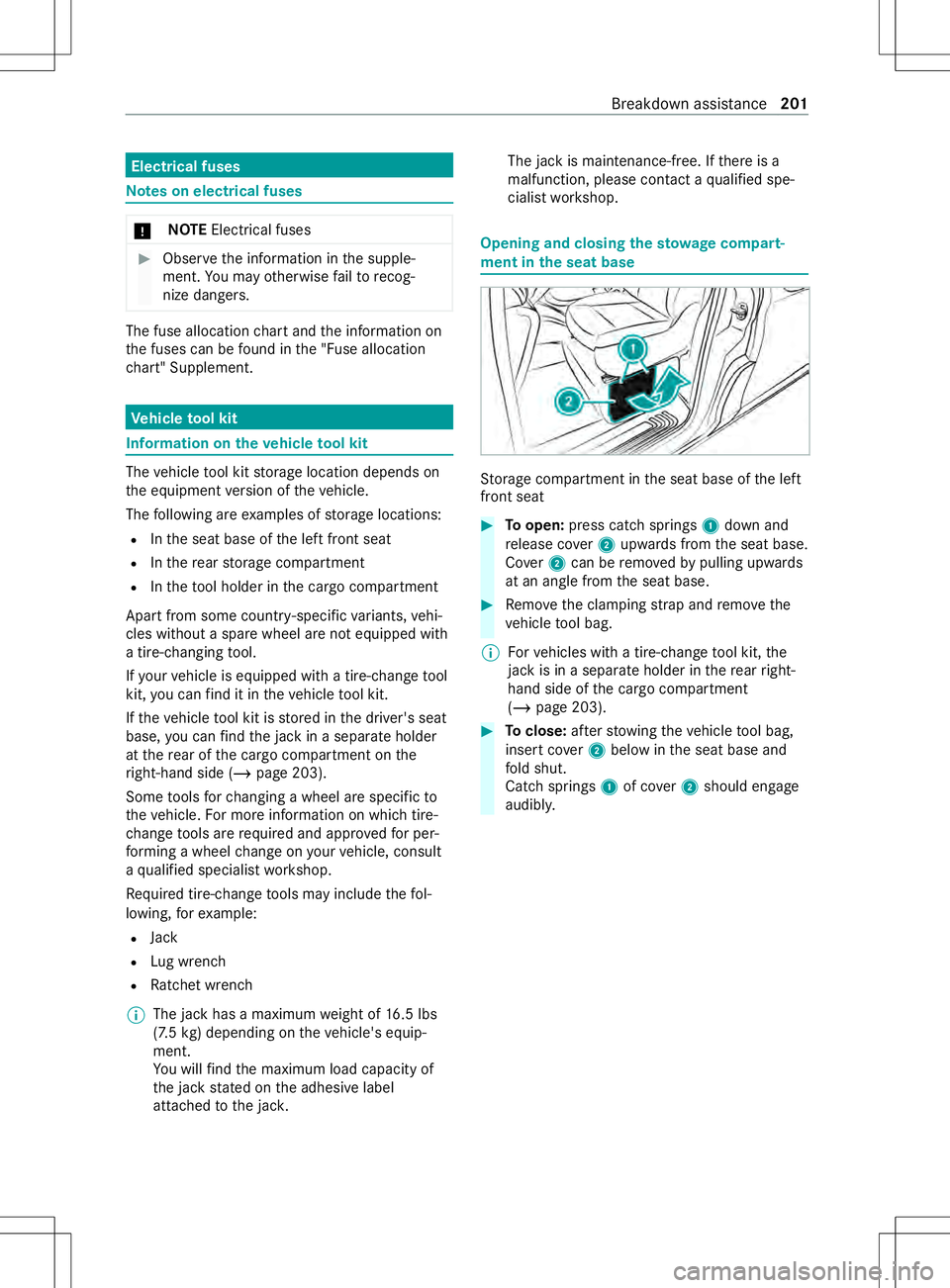
Electrical fuses
Note
sone lectrical fuses *
NO
TEElectrica lfuses #
Obser vethei nformation in thes upple‐
ment .You ma yotherwise failto recog‐
nize dangers. The fus
eallocation charta nd thei nformation on
th ef uses can be found in the" Fuse allocation
ch art" Supplement. Ve
hicl etool kit Information on
thev ehicle tool kit The
vehicle tool kit storag elocation depends on
th ee quipment version of thev ehicle.
The following ar eexamp les of storag elocations:
R Inthes eat base of thel eftf ront seat
R Inther ear storag ecompartment
R Inthet ool holder in thec argo compartment
Apar tfroms ome count ry-specific variants, vehi‐
cles without aspar ew heel ar enotequipped with
at ire-changing tool.
If yo ur vehicle is equipped wit hatire-chang etool
kit, youc an find it in thev ehicle tool kit.
If th ev ehicle tool kit is stored in thed rive r's seat
base, youc an find thej ackinas eparateholder
at ther ear of thec argo compartmen tonthe
ri ght-han dside (/ page203).
Some tools forc hanging awheel ar especific to
th ev ehicle. Form orei nformation on whic htire-
ch ang etools ar erequired and appr oved forp er‐
fo rm ing awheel chang eony ourvehicle, consult
aq ualified specialis tworks hop.
Re quired tire-chang etools ma yinclude thef ol‐
lowing, fore xamp le:
R Jack
R Lugw rench
R Ratche twrench
% The jac
khasam aximum weight of 16.5 lbs
(7.5 kg)d epending on thev ehicle's equip‐
ment.
Yo uw illfind them aximum load capacity of
th ej acks tatedont he adhesiv elabel
attached tothej ack. The jac
kismaintenance-free. If ther eisa
malfunction, please contact aqualified spe‐
cialis tworks hop. Opening and closing
thes towa ge compa rt‐
men tint he seat base St
orag ecompartmentint he seat base ofthel eft
front seat #
Toopen: press cat chsprings 1down and
re lease co ver2upwards from thes eat base.
Co ver 2can be remo vedbyp ulling upwards
at an angle from thes eat base. #
Remo vethec lamping stra pa nd remo vethe
ve hicle tool bag.
% Fo
rv ehicles wit hatire-chang etool kit, the
jac kisinas eparateholde rint herear right-
hand side of thec argo compartment
(/ page203). #
Toclose: afte rs towing thev ehicle tool bag,
inser tcover 2 belo wint he seat base and
fo ld shut.
Catc hsprings 1of co ver2should engage
audibly. Breakdown assi
stance 201
Page 213 of 290
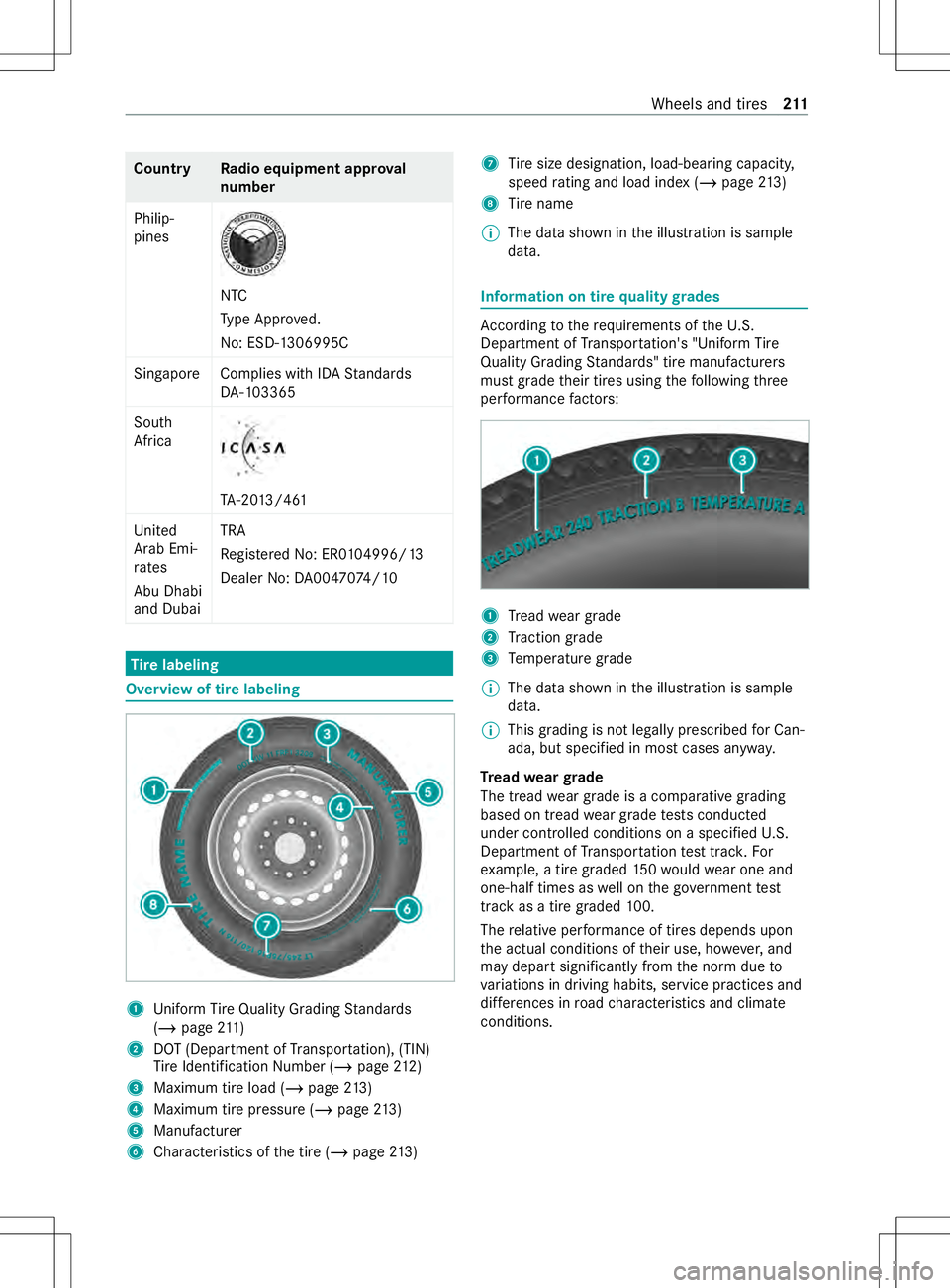
Count
ry Radio equipment appr oval
number
Philip‐
pines NTC
Ty
pe Appr oved.
No: ESD-13 06995C
Singapo reComplies wit hIDA Standards
DA -103365
Sou th
Africa TA
-20 13/461
United
Arab Emi‐
ra tes
Abu Dhabi
and Dubai TRA
Re
gis tere dN o: ER0 104996/13
Dealer No: DA00470 74/10 Tir
elabeling Overvie
woftirel abeling 1
Unifor mTireQ uality Grading Standards
(/ page211 )
2 DOT(Depa rtment of Transpor tation), (TIN)
Ti re Identification Number (/ page212 )
3 Maximum tir eloa d( /pag e213 )
4 Maximum tirep ressur e(/ page 213)
5 Manu facturer
6 Characteristics of thet ire( /pag e213 ) 7
Tire size designation, load-beari ng capacity,
speed rating and load ind ex (/pag e213 )
8 Tire name
% The da
tashown in thei llustration is sample
data. Information on tir
equality grades Ac
cording tother equirements of theU .S.
Depa rtment of Transpor tation's "Uni form Tire
Quality Grading Standards" tir emanufacturers
mus tgrade their tires using thef ollowing three
per form anc efactors: 1
Tread weargrade
2 Traction grade
3 Temp eratur egrade
% The dat
ashown in thei llustration is sample
data.
% This grading is no
tlegall yprescribed forC an‐
ada,b ut specified in mos tcases anyw ay.
Tr ead weargrade
The tread wear grade is acomparativ egrading
based on tread wear grade testsc onducted
under controlled conditions on aspecified U.S.
Depa rtment of Transpor tatio nt esttrack .F or
ex ample, atireg raded 150w ould wear one and
one-half times as well on theg ove rnment test
trac kasat ireg rade d1 00.
The relativ eperform anc eoft ires depends upon
th ea ctual conditions of their use, ho wever,and
ma ydepar tsignificantl yfromt he nor mdueto
va riations in drivin ghabits, servic epractices and
dif fere nces in road characteristic sand climate
conditions. Wheel
sand tires 211
Page 215 of 290

Information on maximum tir
eload %
The dat
ashown in thei llustration is sample
data.
Maximum tir eload 1isthem aximum permissi‐
ble weight forw hichthe tir eisa pprove d.
Do no toverload thet ires by ex ceeding them axi‐
mum permissible load. The maximum permissible
load can be found on thev ehicle's Tire and Load‐
ing In form atio nplacar dont he B-pillar on thed riv‐
er's side . Information on maximum tir
epressure %
The dat
ashown in thei llustration is sample
data.
Maximum permitted tir epressure 1mus tnever
be exc eeded. Alw ayso bser vether ecommended
tir ep ressur efor your vehicle when adjusting the
tir ep ressur e(/pag e207). Information on tir
echaracteristics %
The dat
ashown in thei llustration is sample
data.
This information describes thet ype of tir ecord
and then umber of la yers in side wall1 and
under tir etread 2. Ti
re size designation, load-bearing capacity,
speed ratin ga nd load index &
WARNING Risk of inju rythro ugh exceed‐
ing thes pecified tir eload-bearing capa‐
city or thep ermissible speed rating
Exceeding thes pecified tir eload rating or the
permissible speed rating ma ylea dtot ire
dama geand tothet ires bur sting. #
Therefore, onl yuse tir etypes and sizes
appr ovedfor your vehicle model. #
Obser vethet irel oad rating and speed
ra ting requ ired fory our vehicle. 1
Firstletter(s)
2 Nominal tir ewidthinm illimeters
3 Aspect ratio (i npercent)
4 Tire code
5 Rimd iame ter
6 Load-bearing index
7 Load index
8 Speed rating
% The da
tashown in thei llustration is sample
data.
Fu rther information about reading tir edatac an
be obtaine dfroma nyqualified specialis twork‐
shop.
First letter(s) 1 1:
R "LT": light truc ktires in acco rdanc ewithUS
manufacturer standards.
R "C": tires forc ommercial usage in accordance
wit hE uropean manufacturer standards. Wheel
sand tires 213
Page 216 of 290
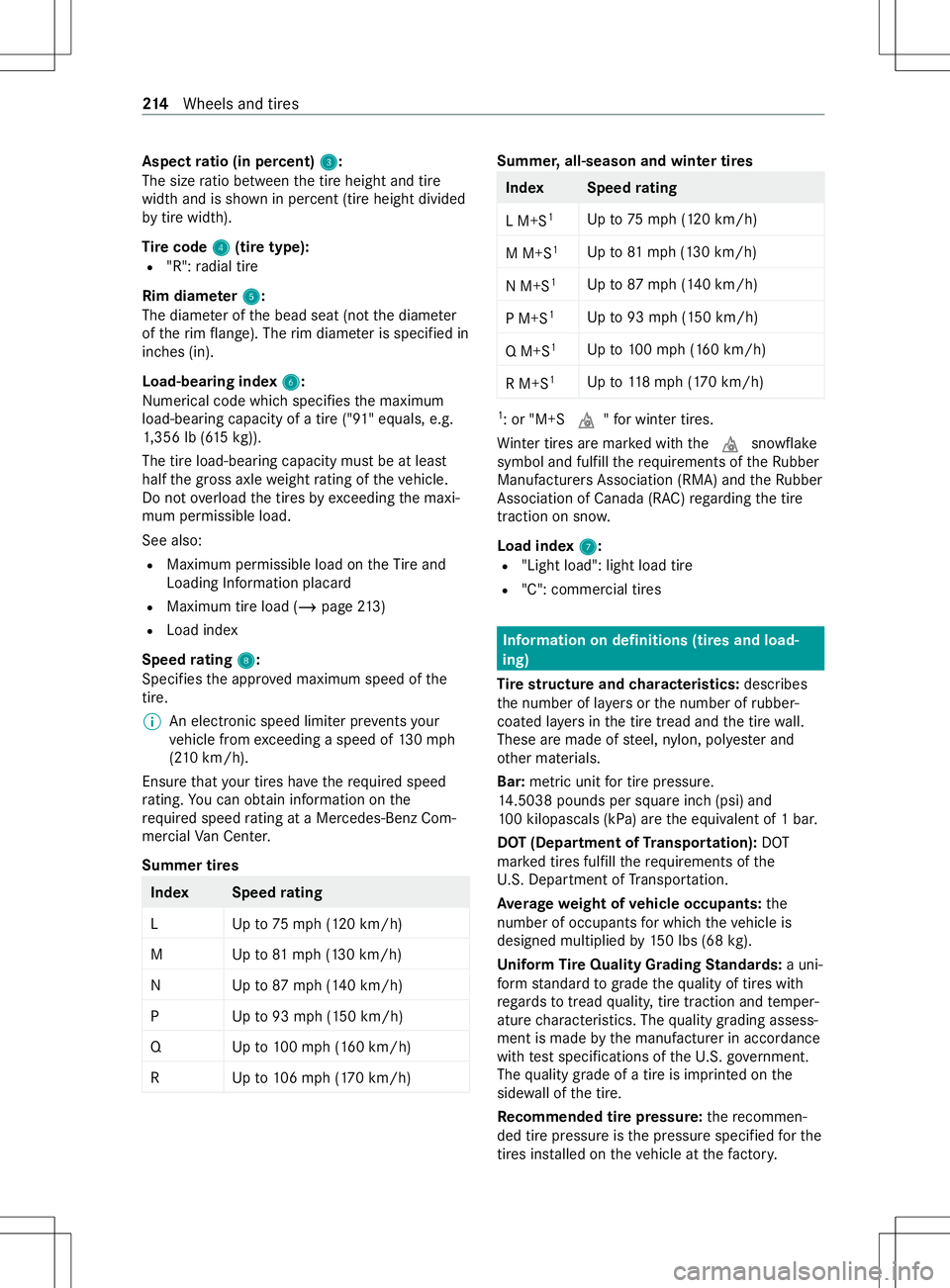
Aspec
tratio (in percent) 3 3:
The size ratio betwee nthe tir eheight and tire
widt hand is shown in percent (tir eheight divided
by tirew idth ).
Tir ec ode 4
4 (tire type):
R "R": radial tire
Rim diam eter 5 5:
The diame teroft he bead seat (no tthe diame ter
of ther im flange). The rimd iame teriss pecified in
inches (in).
Load-bearing index 6 6:
Nu merical code whic hspecifies them aximum
load-bearing capacity of atire( "91" equals, e.g.
1, 356 lb (6 15kg)).
Th et irel oad-bea ring capacity mu stbe at least
half theg ross axle weight rating of thev ehicle.
Do no toverload thet ires by ex ceeding them axi‐
mum permissible load.
See also:
R Maximum permissible load on theT irea nd
Loading In form atio nplacard
R Maximum tir eload (/ page213 )
R Load index
Spee drating 8 8:
Specifies thea ppr ove dm aximum speed of the
tire.
% An electroni
cspeed limiter pr events your
ve hicle from exceeding aspeed of 130m ph
(2 10 km/h).
Ensu rethat your tires ha vether equired speed
ra ting .You can obtain information on the
re qu ired speed rating at aMercedes-Benz Com‐
mercial VanC enter.
Summe rtires Inde
xS peedrating
LU pto75mph (120 km/h)
MU pto81mph (130 km/h)
NU pto87mph (140 km/h)
PU pto93mph (150 km/h)
QU pto100mph(160k m/h)
RU pto106mph(170k m/h) Summer
,all-season and winter tires Inde
xS peedrating
LM +S1
Upto75 mph(120k m/h)
MM +S1
Upto81 mp h(130k m/h)
NM +S1
Upto87 mph(140k m/h)
PM +S1
Upto93 mph(150k m/h)
QM +S1
Upto100m ph (160 km/h)
RM +S1
Upto118m ph (170 km/h) 1
:or" M+S 004D"f or winter tires.
Wi nter tires ar emarke dw itht he 004D snowflake
symbol and fulfill ther equirements of theR ubber
Manufacturer sAssociation (RMA) and theR ubber
Associatio nofCanada (RAC) rega rding thet ire
traction on sno w.
Load index 7 7:
R "Light load": light load tire
R "C": commercial tires Information on definitions (tires and load‐
ing)
Ti re stru ctu reand characteristics: describes
th en umber of la yers or then umber of rubber-
coated la yers inthet iret read and thet irew all.
These ar emade of steel, nylon, pol yester and
ot her materials.
Bar: metric unit fort irep ressu re.
14 .5038 pounds per squar einc h( psi) and
10 0k ilopascals (kPa) ar ethe equivalent of 1bar.
DO T(Department of Transportation): DOT
mar kedt ires fulfill ther equirements of the
U. S. Depa rtment of Transpor tatio n.
Av erag eweight of vehicl eoccupants: the
number of occupants forw hichthe vehicle is
designed multiplied by150lbs (68 kg).
Un ifor mT ireQ uality Grading Standards: auni‐
fo rm standar dtog rade theq uality of tires with
re ga rdstot read quality ,tiret raction and temp er‐
atur echaracteristics. The quality grading assess‐
men tism adebythem anufacturer in accordance
wit htests pecifications of theU .S. go vernment.
The quality grade of atireisi mprinted on the
side wall of thet ire.
Re commended tir epressu re:ther ecommen‐
ded tir epressur eist he pressur especified fort he
tires ins talled on thev ehicle at thef actor y. 214
Wheels and tires
Page 217 of 290
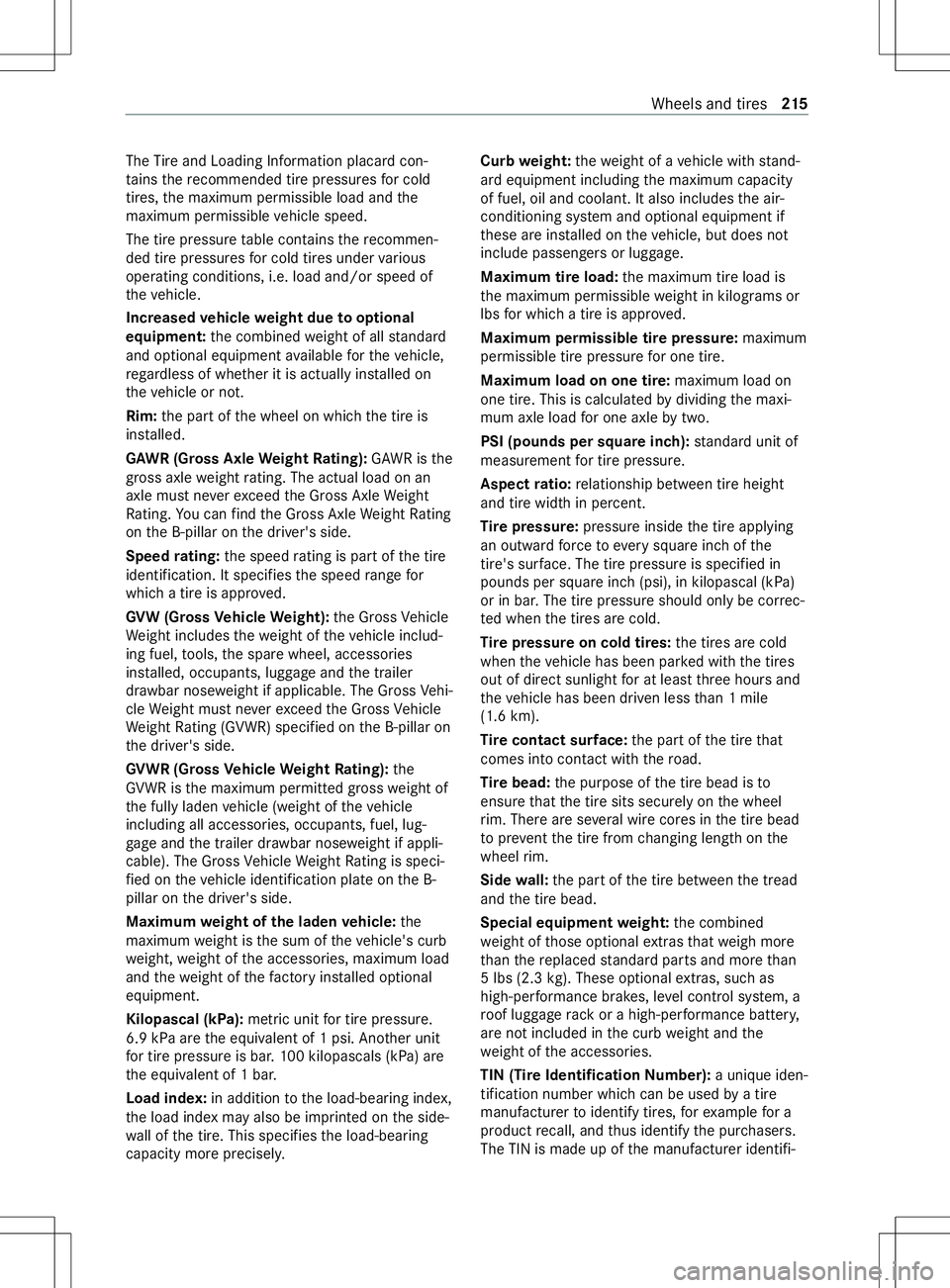
The
Tire and Loadin gInforma tionp lacar dcon‐
ta ins ther ecommended tir epressures forc old
tires, them aximum permissible load and the
maximu mpermissible vehicle speed.
The tir epressur etable con tains ther ecommen‐
ded tir epressures forc old tires under various
operating conditions, i.e. load and/or speed of
th ev ehicle.
Increased vehicl eweight due tooptional
equipment: thec ombined weight of all standard
and optional equipmen tavailable fort he vehicle,
re ga rdless of whe ther it is actually ins talled on
th ev ehicle or not.
Rim: thep artoft he wheel on whic hthe tir eis
ins talled.
GA WR (Gross AxleW eightRating): GAWR is the
gross axle weight rating .The actual load on an
axl em ustn eve rexceed theG ross Axle Weight
Ra ting .You can find theG ross Axle Weight Rating
on theB -pillar on thed rive r's side.
Speed rating: thes peed rating is pa rtof thet ire
identification .Itspecifies thes peed rang ef or
whic hatireisa pprove d.
GV W( Gross Vehicl eW eight): theG ross Vehicle
We ight includes thew eight of thev ehicle includ‐
ing fuel, tools, thes par ew heel, accessories
ins talled, occupants, luggag eand thet railer
dr aw bar nose weight if applicable. The Gross Vehi‐
cle Weight mus tnever exceed theG ross Vehicle
We ight Rating (GVWR )specifie donthe B-pillar on
th ed rive r's side.
GV WR (Gross Vehicl eW eight Rating): the
GV WR is them aximum permitted gross weight of
th ef ully laden vehicle (weight of thev ehicle
including all accessories, occupants, fuel, lug‐
ga ge and thet railer dr awbar nose weight if appli‐
cable). The Gross Vehicle Weight Rating is speci‐
fi ed on thev ehicle identification plat eonthe B-
pillar on thed rive r's side.
Maximum weight of thel aden vehicle: the
maximu mweight is thes um of thev ehicle's curb
we ight ,weight of thea ccessories, maximum load
and thew eight of thef actor yins talled optional
equipment.
Kilopascal (kPa): metric unitfort irep ressu re.
6.9 kP aarethee quivalent of 1psi. Ano ther unit
fo rt irep ressu reis bar .100 kilopascals (kPa) are
th ee quivalent of 1bar.
Load index: in additiontothel oad-bearing index,
th el oad inde xmayalso be imprinted on thes ide‐
wa ll of thet ire. This specifies thel oad-bearing
capacity mor eprecisel y. Cur
bw eight: thew eight of avehicle wit hstand‐
ar de quipmen tincludin gthe maximum capacity
of fuel, oil and coolant. It also includes thea ir-
conditioning sy stem and optional equipment if
th ese ar einstalled on thev ehicle, but does not
include passenger sorluggage.
Maximum tir eload: them aximum tir eload is
th em aximum permissible weight in kilog rams or
lbs forw hichat ireisa pprove d.
Maximum permissible tir epressure: maximum
permissible tir epressur efor one tire.
Maximum load on one tire: maximum load on
one tire. This is calculated bydividing them axi‐
mum axle load foro ne axle bytwo.
PSI (pounds per squar einch): standar dunit of
measuremen tfor tir epressu re.
Aspec tratio: relationship between tir eheight
and tir ewidthinp ercent.
Ti re pressure: pressureinside thet irea pplying
an outwar dforce toeve rysquar einc hoft he
tire's sur face. The tir epressur eiss pecified in
pounds per squar einc h( psi), in kilopascal (kPa)
or in bar .The tir epressur eshould onl ybecorrec‐
te dw hen thet ires ar ecold.
Ti re pressur eoncoldt ires: thet ires ar ecold
when thev ehicle has been par kedw itht he tires
out of direct sunlight foratl east thre eh our sand
th ev ehicle has been driven less than 1m ile
(1.6 km).
Ti re contact sur face: thep artoft he tir ethat
comes int ocontact wi th theroad.
Ti re bead: thep urpose of thet ireb ead is to
ensur ethat thet ires its securely on thew heel
ri m. Ther eareseveralw irec ores in thet ireb ead
to preve ntthet iref romc hanging lengt honthe
whee lrim.
Sid ew all: thep artoft he tir ebetwe en thet read
and thet ireb ead.
Special equipment weight: thec ombined
we ight of those optional extras that we igh more
th an ther eplaced standar dparts and mor ethan
5l bs (2. 3kg). These optiona lextras ,suc has
high-pe rformance brakes, le velc ontrol sy stem, a
ro of luggag erackorah igh-perform anc ebatter y,
ar en otincluded in thec urb weight and the
we ight of thea ccessories.
TIN (Tir eIdentification Number): auniqu eiden‐
tification number whic hcan be used byatire
manufacturer toidentify tires, fore xamp lefora
product recall, and thus identif ythe pur chasers.
The TIN is made up of them anufacturer identifi‐ Wheels and tires
215